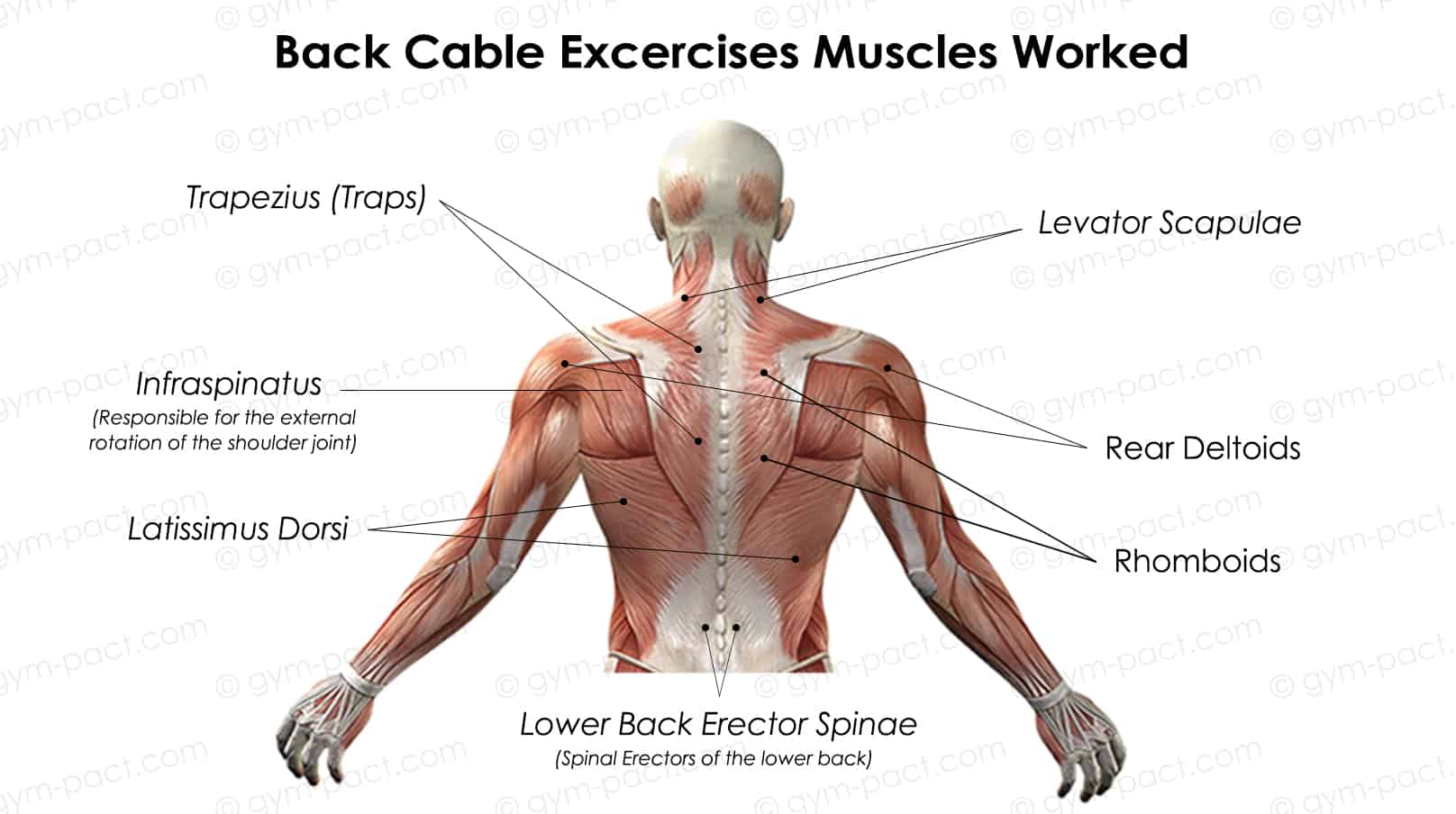Back workouts can often be left behind by gym-goers in favor of the more visible ‘mirror’ muscles. But back exercises not only contribute to your overall muscle mass, but they also have many other benefits.
Back training has been shown to protect against, and help recover from lower back pain. Trials have found the particular benefits of strength training for women with back pain.
Cable exercises for your back have several unique advantages over other methods of training. They are a great way to simulate one-handed pulling movements from various angles, which are commonly used in many functional daily activities.
Cable exercises also allow you to train your back without loading the spine as many free weight exercises do. They also provide a consistent load across the full range of motion and at various pulling speeds.
The range of exercises provided in this article cover all the major muscle groups of your back, including the latissimus dorsi, trapezius, rhomboids, rear deltoids, levator scapulae, the external rotator cuff muscles, and the spinal erectors of the lower back.

Give them a try and enjoy a more balanced physique, stronger joints, improved posture, and decreased risk of injury or pain.
The Best Cable Exercises for Your Back
1. Lat Pulldown
One of the staple cable back exercises, the lat pulldown is a great compound vertical pull exercise for your back. This exercise helps create a wide V-taper look from your shoulders down to your hips.
How to perform:
- Lock your thighs under the pad with your feet flat on the floor and your knees at 90 degrees.
- Take hold of the bar with palms facing downward, the hands shoulder-width or with a slightly wide grip, and lean back slightly at the hips.
- Engaging the lats, draw the shoulder blades down and back as you draw the bar to your collar bone.
- Slowly raise the bar back to the starting position.
A good starting point on the lat pulldown cable machine is three sets of 10-15 repetitions, focusing on initiating the movement from the shoulder blades in a smooth, controlled manner.
2. Underhand Pulldown
A useful variant of the lat pull, this exercise allows you to achieve a greater stretch of the lats at the top of the movement, putting them through a larger overall range of motion. The underhand grip also enables you to recruit the biceps into the movement and pull more weight, achieving greater overload on the back muscles.
The steps of this exercise are similar to those described above, however, the hand grip on the bar is shoulder-width apart with the palms facing upward. Try to still initiate the movement from the back to avoid this becoming an arm exercise.
Due to the greater overall muscle recruitment of this variant, you may be able to lift more weight; try three sets of 8-10 repetitions.
3. Straight-arm Pulldown
Cable pulldowns create a strong contraction of the lats while also requiring stabilization from the triceps and core. The move trains the lats through the sagittal plane, focusing on extension rather than adduction at the shoulders.
How to perform:
- Attach a straight bar to the upper pulley handle of the cable machine.
- Hold the bar at shoulder width and step back until you are standing with the arms outstretched, knees soft, and feet hip-width apart.
- Keeping the elbows locked, engage the lats and pull the bar down to your hips, hold, and slowly control the handle back to the starting position.
Start this exercise at a lighter weight for three sets of 10-15 repetitions to master the correct form.
4. Seated Cable Row
A staple mid-back exercise, the seated cable row focuses on scapular retraction, recruiting the middle traps and rhomboids to build a thicker back musculature and improve your posture. It is also a good alternative to the bent over row for those with lower back troubles, as cable rows aren’t performed against gravity.
How to perform:
- Set up on the seated cable row machine with your feet on the pads and knees slightly bent.
- Use the neutral handle attachment to allow your elbows to be closer to the torso.
- Sit up with a straight spine, lean back slightly at the hips, and draw your shoulder blades together, pulling the handle towards your sternum.
- Hold for a second, and straighten the arms back to the starting position without letting the weight around your back.
This is a great compound exercise, so build up to a heavier weight over a few sessions, with three sets of 8-10 reps.
5. Archer Row
This single-arm cable row is an excellent way to improve your trunk rotation. It will require coordination of your legs, core, and upper body to provide a sturdy base as you rotate.
How to perform:
- Set up a single side handle on the cable machine at shoulder height.
- Stand side-on to the handle with a wide stance, holding the cable with your working arm and your shoulders toward the pulley.
- Bracing your lower body and core, draw the handle toward your working armpit as you rotate your upper body away from the machine as if you were drawing back a bowstring.
Again, start lighter on this move with two to three sets of 10-15 on each side.
6. Cable Upright Row
This exercise is a great example of the cable machine being the superior means of performing an exercise when compared to free weights. The angle of the resistance provided by the cable makes the upright row more effective and safer for the shoulder joints when performing this exercise.
The technique involves facing the low cable with feet shoulder-width apart, or with a staggered stance for balance.
How to perform:
- Using the rope attachment, stand straight and squeeze your upper back as you pull the handles toward your armpits.
- Keep your chest lifted as you lower back to the starting position.
This move needs to be done with a strict form to avoid any strain to the shoulders, so start light with three sets of 10-15 reps.
7. Cable Shrug
No back workout would be complete without hitting ‘the’ upper back muscles, the upper traps. While cable machines may not be the heaviest means of training this muscle group, they provide a safe angle, consistent resistance across the movement, and allow a great contraction.
How to perform:
- With your body facing the low cable machine, pull the straight bar handle up so your hands are in front of your thighs with elbows straight.
- Keeping the elbows locked, shrug your shoulders up and back, holding for one or two seconds before slowly lowering down.
- You can also use a wide grip for this exercise if it feels more natural for you.
You’ll be able to go heavier on this one but make sure to focus on the contraction at the top of the movement for three sets of 10-12 reps.
8. Face Pulls
The face pull is one of the most popular cable machine exercises for the rotator cuff muscles, improving the posture and keeping the joints safe for heavier upper back exercises.
How to perform:
- Attach the rope handles to a high cable.
- Stand in a staggered stance facing the pulley, far enough away to allow your arms to be fully outstretched holding the handles.
- Pull your elbows out and back and externally rotate your shoulders, trying to get your hands to either side of your head above your ears.
- Slowly control the movement back to the starting position.
The face pull is mainly for injury prevention and joint strengthening, so you’ll only need a very light weight to perform it; try three sets of 12-15 reps.
9. Lawn Mowers
Another variant of a single-arm cable row, the lawn mower also trains your torsional strength while allowing you to lift more weight than the archer row due to greater involvement of the upper traps.
How to perform:
- Stand with the lower cable handle to the side of your body.
- Pivot your distant foot as you rotate down to grab the handle.
- Driving through the close foot, retract your working shoulder blade as you rotate and pull the handle towards your upper chest.
Start with three sets of 10-12 reps on each side, focusing on technique to protect the lower back.
10. Reverse Flys
The last of our top 10 cable exercises is one of the best cable machine exercises for the posterior deltoids, an important muscle that can be forgotten in many a back workout. These muscles add to the V-shaped torso look many athletes aspire to.
How to perform:
- Stand between two single-side cable attachments, with the cable handles at eye level.
- Reaching your hands across the body to grab the handles on the opposite side, step one foot back and lift the chest to stand tall.
- Pull your hands across each other and behind the body, and make sure to avoid leaning posteriorly to assist the movement.
- Slowly return back across to the start, and don’t let the chest collapse.
Again, start with a light weight to allow the muscles to go through a full range of motion, with three sets of 10-12 reps.
Back Up!
We hope this article has helped explain the benefits of these exercises. Let us know your favorite cable exercises in the comments below!
Frequently Asked Questions
How do you train back on a cable machine?
Setting up a cable machine is simply a matter of adjusting the handle height, attaching the right handle, setting any seat or pad for your height, and using the pin-loaded weight to select the right load for your set.
What machines work out your back?
Cable machines for your back include the lat pulldown machine, seated row machine, and the adjustable cable frame that allows you to do single or double-sided exercises at various height settings.
What is the best exercise for the back?
While there is no single ‘best’ exercise for the back, two of the best in this article would be the lat pulldown (either variant) or the cable row; these are large muscle groups, compound exercises that allow you to lift heavy.
What are cable exercises good for?
Cable machines are valuable tools for loading the chosen muscle group while placing less stress on the joints.







